deployment of the PLA Navy ships in the - Information Resource ...
deployment of the PLA Navy ships in the - Information Resource ...
deployment of the PLA Navy ships in the - Information Resource ...
You also want an ePaper? Increase the reach of your titles
YUMPU automatically turns print PDFs into web optimized ePapers that Google loves.
FFFFFFFFFFFFFFFFFFF<br />
delegate authority and <strong>the</strong> level <strong>of</strong> trust <strong>the</strong>y are will<strong>in</strong>g<br />
to show <strong>in</strong> co-operation partners not firmly under <strong>the</strong>ir<br />
control. These differences are much less pronounced<br />
<strong>in</strong> navies and air forces, compared to armies that are<br />
much more dom<strong>in</strong>ated by <strong>the</strong> medium <strong>in</strong> which <strong>the</strong>y<br />
work and <strong>the</strong> technology <strong>the</strong>y have to use to be<br />
effective.<br />
EXPERIENCES OF COMMERCIAL SHIPS AND<br />
NATO<br />
Commercial Practice<br />
The design, operation and ma<strong>in</strong>tenance <strong>of</strong><br />
naval assets are generally shrouded <strong>in</strong> different levels<br />
<strong>of</strong> secrecy, and <strong>the</strong>refore to ma<strong>in</strong>ta<strong>in</strong> certa<strong>in</strong> unique<br />
characteristics, standards followed for procur<strong>in</strong>g<br />
various equipment and systems are not very open.<br />
The designers, operators and ma<strong>in</strong>ta<strong>in</strong>ers are required<br />
to be specifically tra<strong>in</strong>ed <strong>in</strong> all <strong>the</strong> ship borne<br />
equipment, <strong>the</strong>reby <strong>in</strong>creas<strong>in</strong>g <strong>the</strong> time and costs. The<br />
equipment manufacturers are also take advantage <strong>of</strong><br />
such a situation by mark<strong>in</strong>g up <strong>the</strong> prices.<br />
On <strong>the</strong> o<strong>the</strong>r hand commercial ship owners<br />
follow very different procedures from those historically<br />
followed by <strong>the</strong> Navies to ensure that when <strong>the</strong>y<br />
procure new vessels and equipment that is delivered<br />
is precisely what is required. There are many reasons<br />
for this: commercial shipp<strong>in</strong>g is generally simpler; <strong>the</strong><br />
legislative framework is different, and <strong>the</strong>re are many<br />
more shipyards worldwide with <strong>the</strong> necessary skills for<br />
build<strong>in</strong>g <strong>the</strong>se <strong>ships</strong>. To ensure that commercial<br />
shipp<strong>in</strong>g is designed, built and ma<strong>in</strong>ta<strong>in</strong>ed to an<br />
acceptable level <strong>of</strong> safety, whilst meet<strong>in</strong>g <strong>the</strong> specific<br />
requirements <strong>of</strong> <strong>the</strong> owner, <strong>the</strong>re are a number <strong>of</strong><br />
rules and regulations that apply, that do not apply to<br />
<strong>the</strong> naval <strong>ships</strong> and submar<strong>in</strong>es.<br />
Statutory Regulation. Commercial shipp<strong>in</strong>g<br />
is subject to external regulation from much <strong>of</strong> which<br />
war<strong>ships</strong> are exempt. These regulations are produced<br />
under <strong>the</strong> auspices <strong>of</strong> <strong>the</strong> International Maritime<br />
Organisation (IMO). They <strong>in</strong>clude a large number <strong>of</strong><br />
conventions such as <strong>the</strong> International Convention for<br />
<strong>the</strong> Safety <strong>of</strong> Life at Sea (SOLAS), and <strong>the</strong> International<br />
Convention for <strong>the</strong> Prevention <strong>of</strong> Pollution from Ships,<br />
1973, as modified by <strong>the</strong> Protocol <strong>of</strong> 1978 relat<strong>in</strong>g<br />
<strong>the</strong>reto (MARPOL 73/78).<br />
Classification Societies. Classification<br />
societies such as Lloyds Register (LR), Germanischer<br />
Lloyd (GL), and <strong>the</strong> American Bureau <strong>of</strong> Shipp<strong>in</strong>g (ABS)<br />
are organisations that establish and apply technical<br />
standards <strong>in</strong> relation to <strong>the</strong> design, construction and<br />
survey <strong>of</strong> <strong>ships</strong> (and <strong>of</strong>fshore structures). Commercial<br />
shipp<strong>in</strong>g will ei<strong>the</strong>r be ‘<strong>in</strong>’ or ‘out’ <strong>of</strong> ‘class’ and it is a<br />
requirement <strong>of</strong> ‘flag’ adm<strong>in</strong>istrations that all shipp<strong>in</strong>g<br />
so ‘flagged’ must be ‘<strong>in</strong> class.’ The design and<br />
construction components <strong>of</strong> a classification society’s<br />
rules contribute to <strong>the</strong> structural strength and <strong>in</strong>tegrity<br />
<strong>of</strong> essential parts <strong>of</strong> a ship’s hull and its appendages,<br />
and <strong>the</strong> reliability and function <strong>of</strong> <strong>the</strong> propulsion and<br />
steer<strong>in</strong>g systems, power generation and essential<br />
services. They are not, and cannot be used as, a design<br />
code, nor do <strong>the</strong>y generally specify how <strong>the</strong><br />
shipbuilder has to design his systems to meet <strong>the</strong><br />
classification society’s rules. For war<strong>ships</strong>, a number<br />
<strong>of</strong> <strong>the</strong> classification societies have developed sets <strong>of</strong><br />
Naval Ship Rules which can be used to specify stricter<br />
standards, particularly <strong>in</strong> <strong>the</strong> area <strong>of</strong> survivability.<br />
Where <strong>the</strong>y differ from <strong>the</strong> equivalent commercial<br />
rules is that <strong>the</strong>y are not mandated and <strong>ships</strong> can be<br />
assessed as ‘<strong>in</strong> class’ for some components but not for<br />
o<strong>the</strong>rs.<br />
Owner’s Requirements. Commercial ship<br />
owners will require <strong>the</strong> shipbuilder to build and<br />
operate new vessels to <strong>the</strong> rules <strong>of</strong> one <strong>of</strong> <strong>the</strong><br />
Classification Societies to meet <strong>the</strong> requirements <strong>of</strong> <strong>the</strong><br />
relevant Flag State. They will also have a number <strong>of</strong><br />
<strong>the</strong>ir own requirements cover<strong>in</strong>g issues rang<strong>in</strong>g from<br />
pa<strong>in</strong>t scheme to domestic facilities, specifics for cargo<br />
or passenger handl<strong>in</strong>g to bunker capacity. They may<br />
also detail specific equipments to be fitted, use <strong>of</strong><br />
designated sub-contractors to ensure commonality<br />
with vessels already <strong>in</strong> service, and may call up specific<br />
standards for <strong>the</strong> <strong>in</strong>dividual systems and equipments.<br />
Across <strong>the</strong> ship owner’s fleet, characteristics that all<br />
vessels must exhibit may be <strong>in</strong>cluded with<strong>in</strong> <strong>the</strong><br />
Owner’s Ship Specification whilst requirements for an<br />
<strong>in</strong>dividual platform will be <strong>the</strong> subject <strong>of</strong> a set <strong>of</strong> <strong>ships</strong>pecific<br />
Owner’s Requirements. Whilst essential<br />
systems must meet <strong>the</strong> Classification Society rules, <strong>the</strong><br />
owner has considerable scope <strong>in</strong> specify<strong>in</strong>g what he<br />
actually requires <strong>in</strong> his new vessel.<br />
The approach described <strong>in</strong> <strong>the</strong> preced<strong>in</strong>g<br />
paragraphs, followed by <strong>the</strong> commercial ship owners,<br />
thus enables <strong>the</strong>m to seek technical assistance<br />
anywhere <strong>in</strong> <strong>the</strong> world, at whatever time, whenever<br />
FFFFFFFFF SEPTEMBER 2010<br />
FFFFFFFFF12




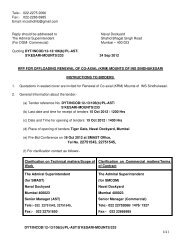

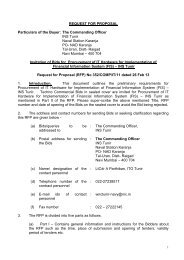
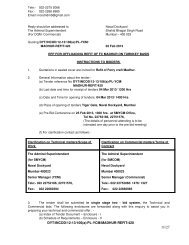
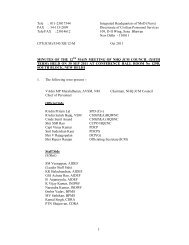

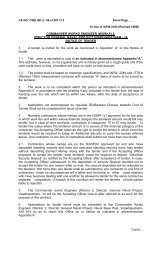
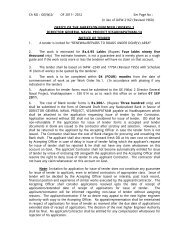

![DGNP[V] - Irfc-nausena.nic.in](https://img.yumpu.com/23509938/1/158x260/dgnpv-irfc-nausenanicin.jpg?quality=85)



